Jan 01, 2026
Jan 01, 2026
A conducted tour of the Baltic States and Russia - St. Petersburg and Moscow - sounded great in our haste to get out of the sweltering heat of Florida. I don’t know if we were successful in avoiding the heat in Russia, which seemed as hot as at home but the sights of the two cities more than compensated for the elusive good weather.
The trip was arranged by Tauck tours, one of the best in the business. A balanced approach to leisurely sightseeing, luxurious hotels and sumptuous meals (always accompanied with wine to toast) were in store for us. We hurried through the Baltic states in order to see the main event - Russia - which stood a short distance across the Baltic sea, like a great bear, inviting and intimidating at the same time.
Here I am presenting my impressions of the Baltic States, Finland and Russia. It is a travelogue of the places we visited interspersed with brief relevant history of countries and of the particular period concerned. Of course, I have injected some of my personal observations and opinions, some of which may be controversial and not agreed upon by all, especially when it comes to current political situation in Russia and its recent history.
Chapter I
The Baltic States and Finland
The Baltic States of Lithuania, Latvia and Estonia, however, have very interesting historical alliances. The three small countries speak different languages and have different currencies (though now they are part of the Euro zone and soon will lose their own currencies). Lithuania was more aligned with Poland, whereas Estonia was under Swedish influence. Latvia, that is between the two has been influenced by both countries and is an amalgam of both in many respects. The origin of language of Estonia is Finno-Ugric (Uralic), whereas Lithuanian and Latvian languages have their origins from the family of Indo-European languages. All the Baltic States were under the rule of Russian Tsars until WWI, after which they were independent until WWII. The Soviets then occupied the Baltic States until its own collapse in 1991. However, Russian influence still exists in its daily life today, and there is an undertow of tension between the natives and the Russians, be it in governance or education.
The night before the sightseeing tour began in Vilnius, we were all gathered for the customary introductions and dinner. We hardly needed any introduction because we were all acquainted with each other, a group of friends and relatives, most of who had gone on similar trips together in the past. The only person we did not know was our tour guide, Anne Marie Brojack. Following drinks and hors d’oeuvres (including caviar, which was left mostly untouched by our group) we had a good sit-down dinner. We added our own flavor to the menu by singing nostalgic Hindi, Kannada and Tulu songs. In the process we shocked our tour guide nonetheless, who had never seen such a bunch ever in her many similar conducted tours.
Vilnius, Lithuania
The Baltic States, which were the first to declare their independence after the turmoil in the former Soviet Union, have made quite a progress towards market economy. It was in Vilnius, the capital of Lithuania, where we began our tour. Vilnius is a historic place and was a prominent city from the medieval times.
As a tourist who has visited the east European countries like Poland, Hungary and Czech Republic, the churches and cathedrals of Vilnius looked a bit drab. However, I was not surprised that Napoleon was so enamored by St. Anne’s church that he wanted to pluck it and take it home to Paris in the palm of his hand! The gothic-styled church constructed in mid-sixteenth century after the original church of 1419 was burnt down by fire, has more or less remained unchanged in the last five hundred years. It is part of a much larger ensemble consisting of church of St. Francis and Bernadine, which looms in its background.
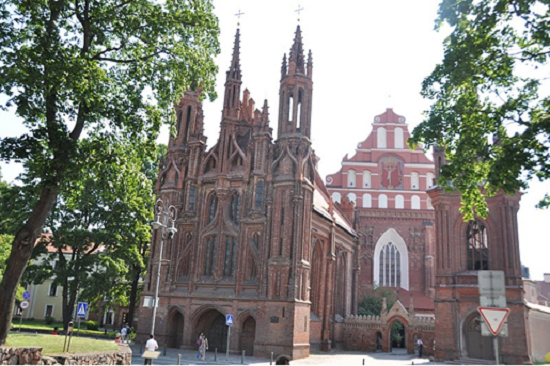
Church of St. Anne
Later in the day we visited the KGB museum. KGB (Komitet gosudarstvennoy bezopasnosti) was the Committee for State Security, a euphemistic term used to describe an organization mired in clandestine and nefarious activities of spying, subversion and torture. Some people in our group compared it to our own Central Intelligence Agency but the activities of the KGB were more cynical and deadly, akin to state sponsored terrorism. In comparison the CIA appeared like boy scouts. We saw the prison cells of inmates who were kept under inhuman conditions as well as torture chambers, where they were “treated” until information was extracted from them. And then they were summarily executed. There was a short video presentation of the enactment of such an execution and disposal of the bodies. It was quite graphic and made the ladies in our group uncomfortable.
Our guide, a handsome middle-aged man, seemed to have dedicated his life to showing people around the museum. He was keen on pointing out the serious atrocities committed by the Soviets with passion and humor as well. Pictures of the executed political opponents and rebels who tried to fight the oppression, and religious leaders like prominent bishops adorned the walls of some of the cells. Our guide told us that he was training his fifteen-year old son to follow his footsteps, and he was passionate about not letting visitors forget the suffering of Lithuanian people under the Soviets. Finally he showed us a picture of himself as a young boy along with his grandmother on one of the walls of the prison cell. His grandfather had been killed because he took part in the resistance movement and his grandmother had been exiled to Siberia to do hard labor. That explained our guide’s dedication to his cause. We left the museum with slight discomfort in our stomachs.
We walked past the president’s residence with its eerily vacant front square, which was quite large. There was not a single uniformed guard or any kind of sentry seen. It almost appeared like the building was abandoned. Apparently the president was not in town as the flagstaff on top of the building was empty. President Dalia Grybauskate is very athletic and a certified black belt holder in karate. Perhaps she does not need any bodyguards but this can happen only in a little country like Lithuania today, without any threat of terrorism whatsoever. The Old Town of Vilnius appeared to have been abandoned as well, (perhaps they left town with their president) with no residents in sight. The Cathedral Square was empty and the town hall seemed to have been shut. But there were roadside restaurants and cafes doing brisk business and signs of newly gained freedom with capitalism could be seen everywhere.
Lithuania has a grand medieval history with the Grand Duchy of Lithuania that later joined Poland to form the Polish-Lithuanian Commonwealth in the sixteenth century. After many wars over centuries the importance of Lithuania diminished and neighboring Poland and Russia gained prominence.
Lunch was arranged in a modern appearing restaurant with a lovely view of the ancient castle at the medieval Trakai, a town built on water and surrounded by many lakes. The restaurant had a lovely view of the Trakai Island Castle, which was situated in the middle of one such lake. The renovated castle contained very little dilapidated furniture, we were told. We were left to our discretion as to a walking tour of the castle. Some in our group braved the heat for a walk up to the castle while others were happy shopping for trinkets. A group of us just sat in the shade and took in the lovely view of the castle on the lake.
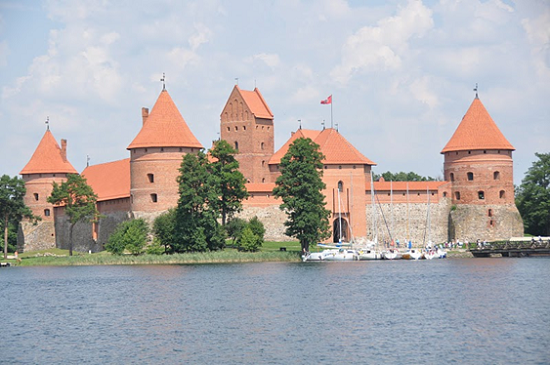
Castle at Trakai
The sixteenth century Gates of Dawn was pointed out to us but we were left to explore it by ourselves. Built as a defensive fortification in the sixteenth century, it contains the chapel of Blessed Virgin Mary, Mother of Mercy, who is said to have miraculous healing powers. Unexpected rains washed away our planned walk up to the Gate that evening, which drenched some of us thoroughly. I somehow escaped the deluge, which was miracle enough for me!
One of the sites we visited was the Cathedral of Vilnius, which has quite a history. It was first built in the site where King Mindaugus was baptized in the thirteenth century, when he converted to Christianity. (However, Christianity did not take hold after the king’s death in Lithuania until later, in the fourteenth century). The changes in the style of construction of the cathedral in the ensuing centuries occurred not just because of different rulers but also because of many fires in the church (at least five). The most recent renovation was in 2008. The cathedral mostly retains its baroque architecture.
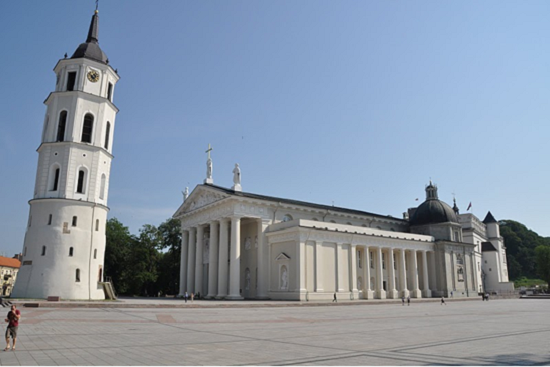
Cathedral of Vilnius
The cathedral houses the burial sites of many from the royal family of medieval times, and most significantly that of Saint Casimir, the patron saint of Lithuania. In a corner of the cathedral there is a richly decorated room where the saint’s remains are interred. There is an interesting silver laden portrait of the saint’s coffin. The face and hands of the painting are visible and strangely the saint has two right hands. The legend says that the artist painted the right hand in a certain way but decided to refashion the hand in a different posture. Next day, when the artist returned to his painting, the erased hand had reappeared. So he decided to leave both right hands visible.
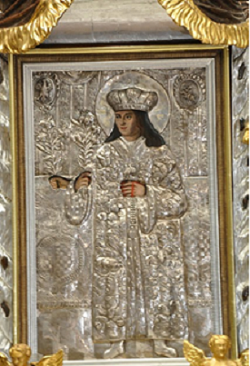
St. Casimir with two right hands
Prince Casimir was the son of a Polish king and he was canonized in the fifteenth century after performing miracles. He is also revered in Poland, where he is referred to as St. Kazimierz. He led a pious life and died at age 25 of lung problems.
Interestingly, the Lithuanian language has many words that sound like Sanskrit words. Our guide seemed to know this and pointed out to several words like dhuma, agni etc. She also proudly stated that her daughter was named agni (or some variation of the word). Another trivial fact is about a statue we passed by in our bus was that of American composer of rock and jazz music, Frank Zeppa. The statue has the head of a mellow appearing Zeppa on a pedestal, in a lonely garden by the side of the road. It is a sculpture done by Saulius Paukstys of Vilnius and he has donated a replica of the sculpture to Baltimore as well. Perhaps these are the only two sculptures dedicated to Frank Zeppa in the world. Zeppa, a controversial figure who had immersed himself in the drug culture of the sixties (yet a legend in his own right), found a home in Vilnius, Lithuania of all the places in the world!
Riga, Latvia
Early next morning we set out on the yellow roads of Europe to another Baltic country, Latvia. The bus journey took about four to five hours through empty landscapes with sporadic farmhouses and farmland. We never saw anyone on the streets in this sparsely populated country. On the way we stopped for restroom and refreshments, which was unique in a quirky way. Apart from the restaurant with picnic style tables there were some animals, including an ostrich and a miniature horse. A couple of rooms appeared as though they were untouched since the medieval centuries.
We stopped in Jurmala en route to Riga for lunch. The restaurant we were taken to was on the shores of Gulf of Finland (Baltic Sea). Some of us braved to dip our toes in the very cold water but for the rest of us it was a photo-op. Riga, the capital city was quite close by and we directly went to the Opera House, an ornate hall with exquisite decorations. It was originally built in the nineteenth century but was re-constructed in the 1990’s.
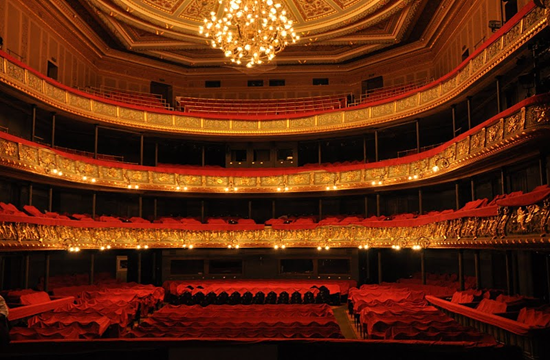
The Opera House at Riga
The surprise element was an operetta singer performing for us in the upper sections and we had a taste of the high octaves produced by a professional opera singer. She even had a comedy act like a drunken woman singing the high notes, swaying and falling, playacting while singing those perfect notes. We were thoroughly entertained by the act. The Opera House itself did not make a lasting impression as we had seen more spectacular construction of such buildings on our trips to the Eastern Europe. But it was good enough to take some pictures and we had the unique opportunity to go on the stage in a real Opera House.
We entered the city and immediately were taken for a walking tour of the Old Town of Riga. Our tour guide Anne Marie Brojack, an overweight woman with a great heart, led us on the tour. She was quite winded walking the distance, and we could not help but hear her heavy breathing as she spoke through our earpieces. But as our tour progressed Anne Marie turned out to be an endearing person and a resourceful guide. We found the Old Town bustling with many small shops and café’s. We stayed in The Grand Palace Hotel, which was right in the middle of the Old Town.
Later, after pizza and a few beers we set out to explore the nightlife in the Old Town. Friday nights must be party night in Riga. Every good-looking couple seemed to be there partying in numerous roadside bars. The nightclubs had open doors (similar to the French Quarters of New Orleans) with dancing girls on the podium in seductive attire. My impression was that it was much cleaner than New Orleans and perhaps a bit more subdued but it had less carnival like atmosphere. We also found people of Riga beautiful and elegant, as we walked along smoking our $30 Cuban cigars. There were no drunks that we could see and everyone seemed to be well behaved. We were told in our tour that a concoction of many herbs and honey and other sweetening agents called the Black Magic, is a healthy drink most people drink in Riga (in small quantity mixed with tea). Our guides also warned us that if one drinks more than 50 grams at one time, one would meet one’s maker! But a healthy daily dose of that concoction was the secret why the people from Riga were handsome and graceful, I wondered.
The following day we went on a tour of the town of Riga, mainly the Art Nouveau New Town. Riga boasts of the highest number of such architectural buildings in the world, most of them constructed at the turn of the 20th century. There are more than 800 such buildings but the most famous ones are on Elizabetes Street, and Albertaand Strelnieku Street. There are dramatic figurines and flowing geometrical ornaments in the front façade of buildings, which are mainly utilitarian dwelling and apartments. Most famous of the architects is Micheal Eisenstein. The Rigan term for the avant-garde movement, which started in 1899, is Jugendstil, derived from a German term Jugend, meaning Youth. And youth and freshness were unmistakable in these magnificent constructions.
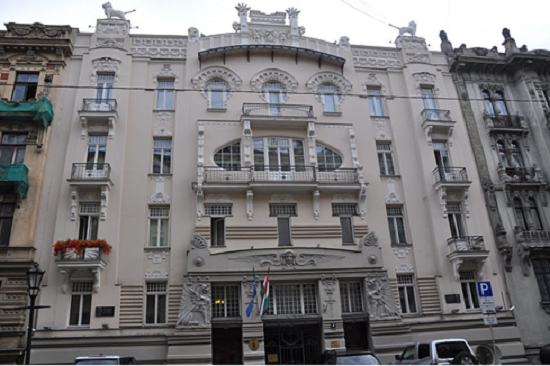
Art Nouveau Building
After feasting our eyes on the gorgeous Art Nouveau buildings we went to see a market that is one of the attractions of Riga. This was no ordinary market. The row of semi-cylindrical buildings is actually converted Zeppelin hangars. It has five separate buildings, each selling a different specialty like fish, meat, dairy products and groceries. In between, every sellable item is displayed in neatly stocked stalls. The flower market carried all varieties of flowers, fresh and fragrant, which seemed to have been just plucked. A walk through this market is a cultural experience, no doubt.
A walking tour of the Old Town revealed many more Art Nouveau buildings, some Rococo styled as well. One interesting building had a great big cat on the top, with its tail raised. It is referred as the Cat House. This caught our eye and we had to ask our guide for its meaning and significance. It so happened that a prominent builder was denied access to a reputed guild in the city, and he designed the cat with its derriere and the raised tail facing the building where the guild members met regularly. Eventually, this act of defiance earned him a membership in the guild (and a court order), and he reportedly turned the cat around so that it faced the building of the guild.
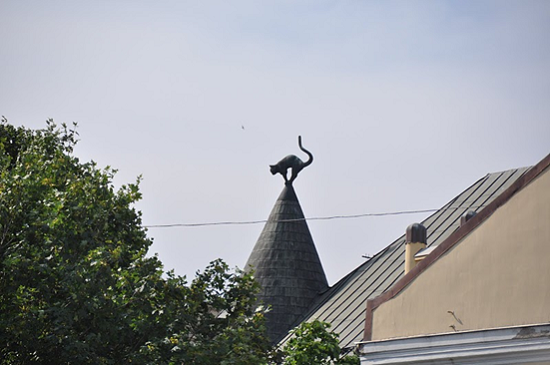
Cat House of Riga
We also walked past the Powder Building, which was used to store gunpowder in the medieval times but now is a Latvian war museum. The language of Latvia is distinct from that of any other Baltic states. The country had suffered much during its occupation by the Soviets. The monument that is held sacred in the hearts of every Latvian is the Freedom Monument. It was built as a protest symbol (against the Soviets) from donations collected from the citizens in 1935 but somehow it survived the Soviet era. At the other end of the line of busy shops, restaurants and nightclubs is the monument that the locals love. It is a monument with the statue of a lady figure (affectionately called Milda) at its apex. It was built in memory of the people deported to Siberia by the Soviets. Milda holds three stars in her hands high above her head, which represent three historic regions of Latvia. The joke is that Milda was a travel agent because if anyone dared place a wreath or a bouquet of flowers at the monument, he or she was assured of a one-way ticket to Siberia!
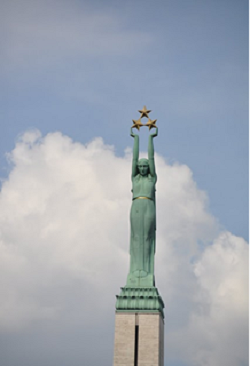
Milda on the freedom monument
Another remarkable building is the renovated 14th century building in the gothic style with a Dutch Renaissance façade. It is the Blackhead’s building, the seating of the powerful merchant guild of the rich and the famous of medieval Riga. It had been destroyed during WWII but was recently renovated to its original splendor. Another landmark is the St. Peter’s church with its wooden spire. It has been restored several times, after it was destroyed by fire. An elevator can take a visitor to the top to enjoy a lovely view of the city (we were not able to see that due to lack of time). It was originally a Catholic church but later became a protestant church after Martin Luther’s reformation. The cross on the spire was replaced by the symbol of the rooster.
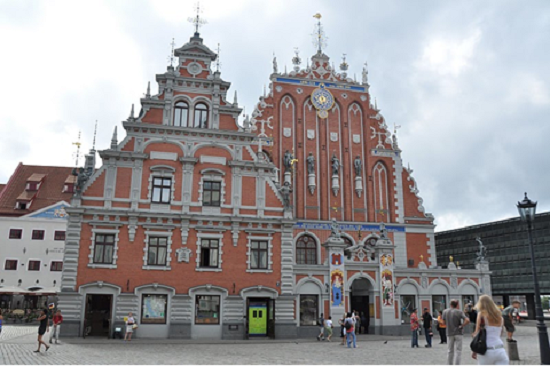
Blackhead’s Building
Christianity was introduced to Latvia in the ninth century but it did not take hold until the twelfth century, only because of the forced conversions by the German crusaders. That was when the country made the switch from Paganism to Christianity, though today we see very little evidence of paganism in the country.
In the afternoon most of us skipped a visit to the Jewish museum and an old Jewish cemetery. I had seen many such places in our East European trip and especially in Krakow, Poland. There cannot be any Jewish memorial as effective as the Nazi concentration camps at Auschwitz and Birkenau or the beautiful synagogues we had seen in East Europe. The majority of the tourists visiting these parts are Jewish, and the program the tourist companies tailor for them always included visits to synagogues and Jewish memorials. We had a hint from our tour guide that this particular site is not an exciting one and hence most of us decided not to go. Instead we decided to relax and appreciate the sights and the beauty of Riga on our own. Before dinner that evening we met again for libations, which was a routine every evening during our trip. Most in the group had brought Scotch whiskey bottles and this was consumed ritually every evening. If yogurt and rice that miraculously appeared during every meal provided the fuel for the Indian vegetarian palates, Scotch whiskey was like mother’s milk. That certainly put everyone at ease. Hotel Grand Palace even provided a DJ and music in its bar for us to drink and dance the night away.
The hotel lobby in the Grand Palace was unique and did not resemble any that I have ever seen. In a room there were two tables with chairs where the attendants sat. Across from them was a cage with a couple of noisy birds (at least one was loud enough to be annoying, while the other bird sat in front of a tiny mirror admiring itself). But the chirping was constant and quite nerve wrecking. When I was checking out the next morning and paying the incidentals, I asked the clerk how he was doing. He had a sad look on his face and he pleaded with me asking me if I wanted to take the bird with me, for which he would be eternally grateful to me. I managed to smile and slowly walk out of there (I thought he was quite serious about his offer).
Tallinn, Estonia and Helsinki, Finland
We were ushered into the bus early in the morning after we checked out of The Grand Hotel. The drive was pleasant and we wiled away our time with singing and munching on the ubiquitous Indian snacks, which seem to appear before us every time we sat down in the bus.
Our lunch was in another seaside town called Parnu. The vegetarian food for many in the group had been pre-ordered and we sat in a hall with large open windows. Outside the window was a busy street with good-looking shoppers, mostly locals, walking up and down the street, like a fashion parade. The TV monitors overhead was playing some Hindi movie for our benefit. Food was excellent and we first tasted the cold beet soup, so popular in these regions. Of course, yogurt and rice had been specially procured for the vegetarians and the indigenous products from India made the rounds at each table, namely the pickles, powders and pastes.
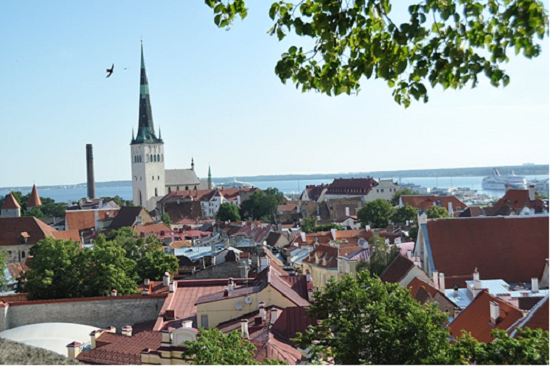
Old Town of Tallinn
Around mid- afternoon we arrived in Tallinn, a quaint medieval town, perhaps not much different than how it would have looked in the 13th century. It is well preserved with its old city walls and guard towers. Many of the towers even have names like Kuldjala, Nunna and Sauna. A walk through the Lower Town was arranged for us the moment we arrived, through streets with some more Art Nouveau buildings, some even older than we had seen in Riga. We walked on street by the church of St. Olaf, another landmark church. We were led to the town hall, which looked much like yet another church. The cobblestone streets and its old buildings with the city wall certainly reminded us of its antiquity and it is no wonder that UNESCO has designated the entire city as World Heritage site.
We were next guided to a bustling market square with many stalls selling anything from wooden dolls to ski sweaters and of course jewelry, the most favorite of the women in our group. Amber jewelry is universal in these parts of the world and most freely available. By the end of the week of our tour there was not a single woman’s neck in our group without an amber necklace! It was a good place to do souvenir shopping but (mercifully) the tour allowed us only about twenty minutes for this activity.
History of Tallinn is that of continuous occupation: first by Danes, then by the German order of Teutonic Knights and then by the Russian Tsars followed by the Soviets. They were strongly aligned with the Swedes until a war in the 18th century, when Peter the Great, the Romanov Tsar of Russia, annexed it.
That evening we had a special dinner arranged for us in the elegant restaurant Gloria, one of the most acclaimed restaurants of Tallinn. We were taken in batches by taxicabs and the ambiance was excellent. The food was good with a four-course gourmet meal and wine.
Estonian tension with the Russians was evident to me in a small and humorous incident in the hotel. Though Estonia was under Swedish influence for a long time, our hotel was called Swissotel. Early in the morning I called the desk to see if any coffee was available at the lobby that I could bring up to our room. The clerk told me that the only way I could get coffee in the room was if I ordered room service. In the interest of time we decided not to do that and go down to the morning breakfast buffet. Soon our doorbell rang and there was a server with eight cups and two large jars of coffee, balancing them neatly on a wide tray. when I told him that there must have been a mistake, he insisted (in broken English) that he was told to bring eight cups of coffee to our room. I called the desk clerk to clarify. He profusely apologized and said that he had asked them to send us two cups of coffee as compliments from the hotel (which was nice), but the server was Russian and had misunderstood the order given in Estonian. So the blame lies on the dumb Russian, I gathered!
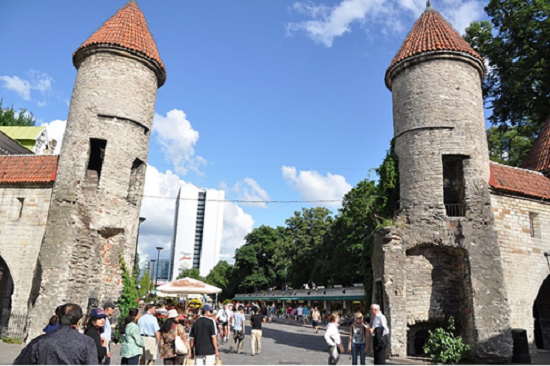
The medieval city wall and the gate
That morning we had some time to explore Tallinn a bit more. We saw a beautiful Russian orthodox church with its rich decor inside. The Russians in the process of “Russianization” of Estonia had built the Alexander Nevsky Church in the nineteenth century. The locals hated it as it became a symbol of occupation and during their first independence (after WWI), it was slated to be demolished. Only the lack of funds and the massiveness of its cupolas prevented its destruction. Later during the Soviet era it was neglected just like all other religious institutions. Only after the independence in 1991 Estonians restored the church to its original splendor. There was a service actively taking place and so we kept our lips tightly shut and watched the process in fascination. The chanting by the priest almost sounded like Sanskrit mantras to us. We walked the parts of the Upper Town and up the Toompea Hill and saw a lovely view of the city from a vantage point. The red-roofed white-walled buildings with the tall spires of many churches and cathedrals and the Baltic Sea as a backdrop made a good spot to take pictures.
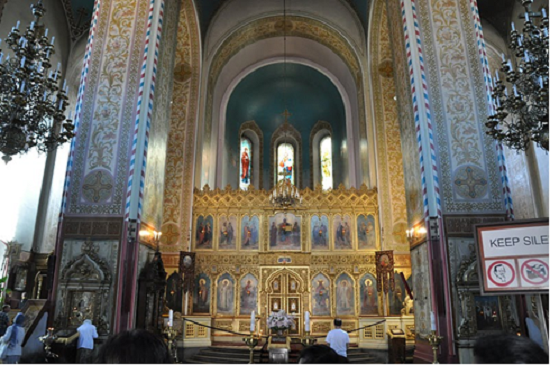
Inside the Alexander Nevsky Cathedral
Then we were leaving Tallinn for Helsinki, by a high-speed ferry. Somehow I felt that Tallinn had more to offer and we did not spend enough time in the lovely city with a great history and well preserved architecture.
The ferry was large with all amenities. It was avoided the crowd as we were traveling in the business class lounge. There were not too many other people in the lounge and the buffet lunch was quite elaborate, along with beer and wine on tap (and of course, Vodka). After a while the swaying of the ferry was indistinguishable from the swaying in our heads from all the drinks! Soon we found ourselves disembarking in the busy port of Helsinki, Finland.
The port at Helsinki appeared to be busy. Docked were many large cruise ships (the floating cities), including the Cunard Queen Victoria and Norwegian Sun. We embarked on to the bus and immediately took a tour of the city, a four cloverleaf shaped city, with water visible from almost everywhere. The Cathedral of Helsinki is the most photographed spot and we were first taken there for our opportunities for photographs. There is a large bronze statue of one of the Russian Tsars in front of the Lutheran Cathedral. His name is Alexander II (Poor Alex, his face and shoulders have turned white and we could see the reason why. A seagull was perched on his head and never left it for the entire duration that we were there). Around the cathedral, a drive through the square showed us the neo-classical buildings of the Senate square dominated by the Government palace, University of Helsinki and the National Library building. Architect Carl Ludwig Engel designed these buildings, as well as the cathedral, in the early nineteenth century. We also saw a colorful market square close to the Senate Square.
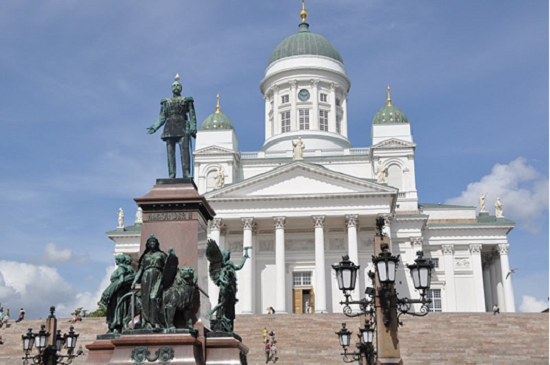
The Cathedral of Helsinki
We then visited a rock church, Temppeliaukio Church, which was unique and looked like an auditorium with a very small, unusually non-ostentatious altar. Built in the 1960’s it had a large circular ceiling, which was made of concentric bands of copper. It had no walls and the natural rocks made its backdrop. The acoustics are so wonderful in the church that it is often used for musical concerts, we were told.
The Sibelius monument with a congregation of steel pipes in the shape of a tree (or a musical instrument) is situated in a lovely park off the beaten path in Helsinki. Sibelius was the musical composer of Finland (died in 1957) and his face made from shiny metal can be seen on a rocky surface in the park.
Our hotel (Hotel Haven) was next to the Esplanade, a lovely park surrounded by shops. We had a nice dinner at a lovely Italian restaurant called Sasso. The menu was excellent and we had a relaxed dinner following which we we went on a walk along the Esplanade and beyond. Helsinki appeared to be rich and resembled many Western European cities, though it seemed to be less commercialized. The buildings looked like they were well maintained and the shops appeared expensive.
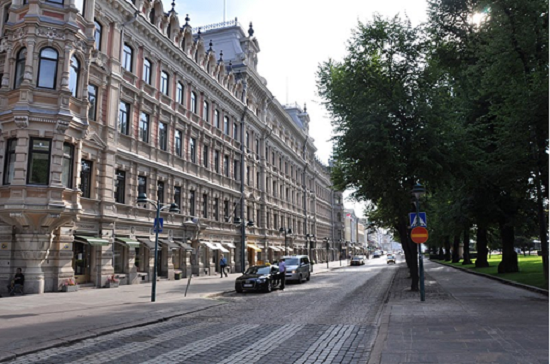
A cobble-stoned street in Helsinki
At the entrance of the Esplanade Park in the center of the busy intersections, where the cable cars and motorcars move briskly, is a fountain with a naked statue of Havis Amanda, a fictional character, who has become a symbol of Helsinki. Ville Vellgren cast this statue in bronze in Paris in 1906, and a 19-year-old girl was said to have been his model. The work belongs to the charming Parisian art nouveau style. Havis Amanda receives a cap by the students every year during the celebration of a festival called Vappu, on the eve of May Day.
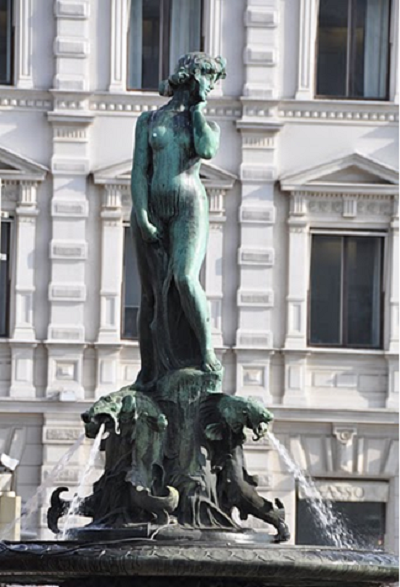
Havis Amanda
The next day it was time for us to take the train to St. Petersburg. We felt that not enough justice had been done to Helsinki in our tour. It is a very popular European town, with a lot of history and worthy sights. If we whizzed through Tallinn in this trip, we covered Helsinki at warped speed. I got the feeling that the trip so far was just a prelude to our second week and our stay in Russia. After all, we had hurried through the Baltics and Finland in five days, staying in four different hotels in four different countries in the process. We had tired ourselves of living out of the suitcases and keeping up to the schedule of packing and repacking every day. I believe we forgot all those inconveniences when we reached St. Petersburg.
Continued to St. Petersburg, Russia
12-Oct-2011
More by : Dr. Neria H. Hebbar